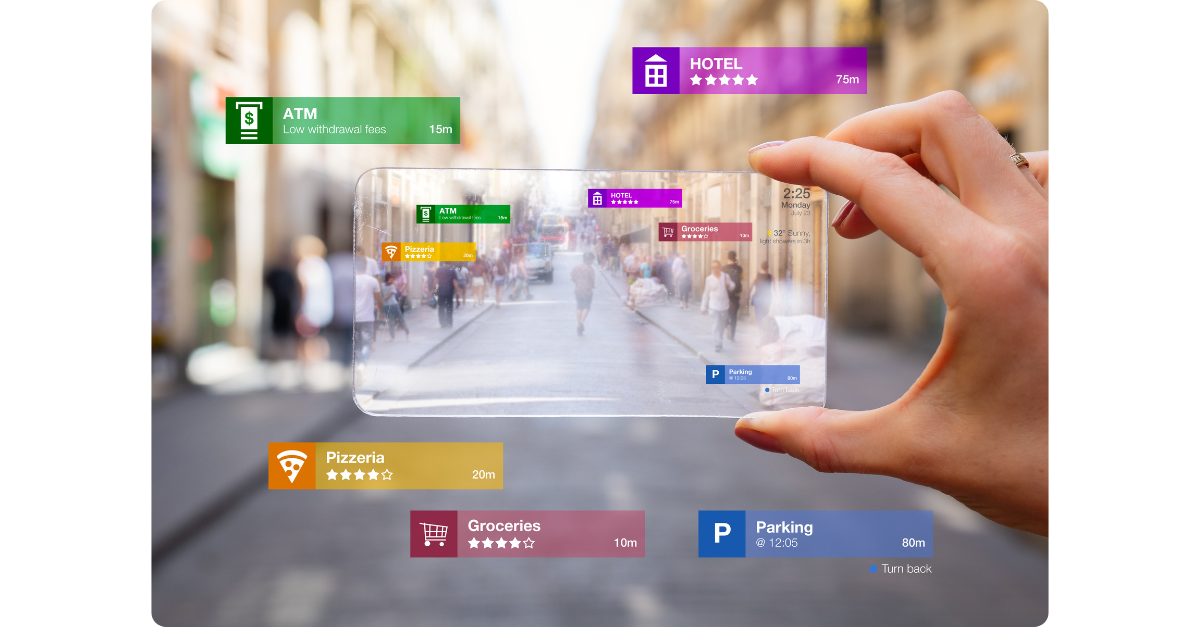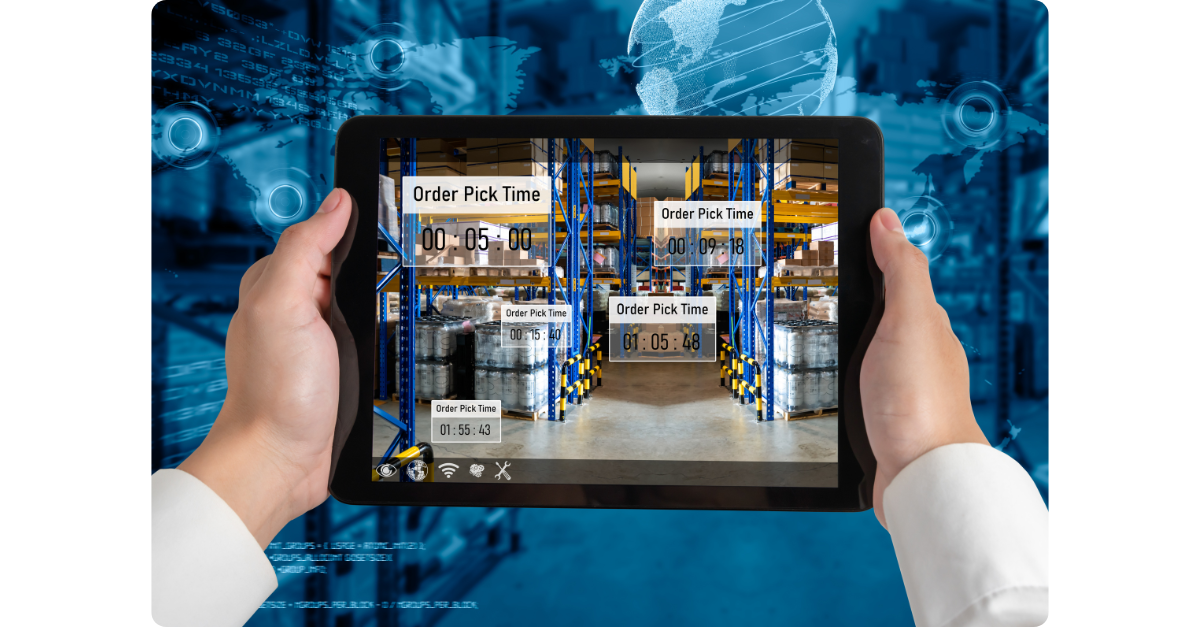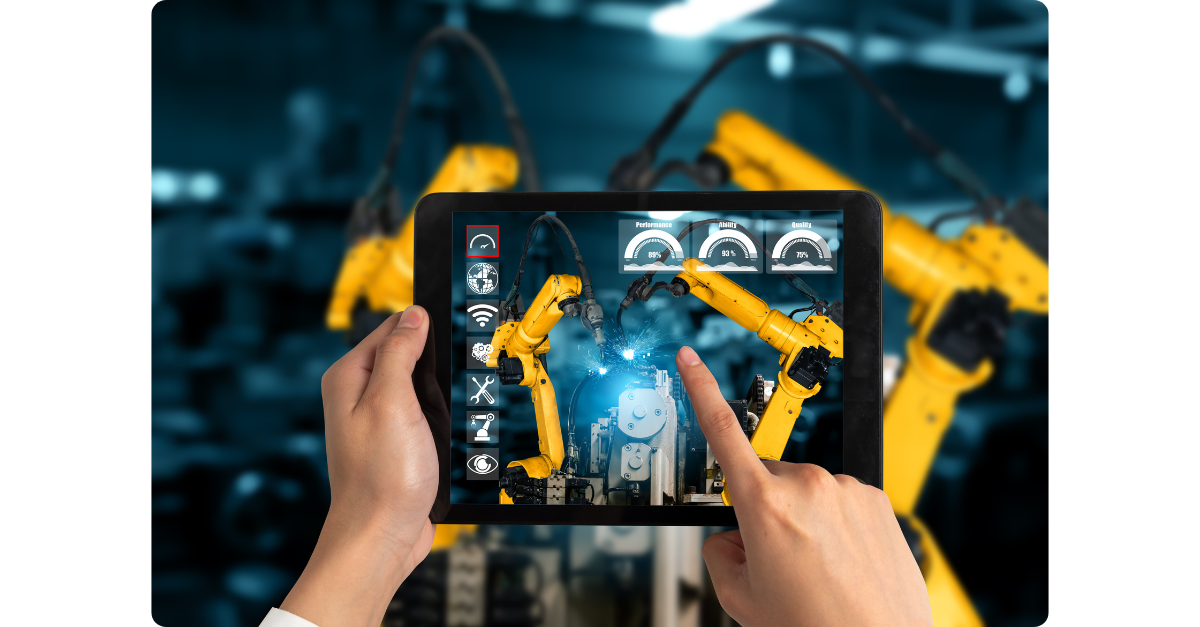From Dream to Reality: How to Turn Your AR Apps Ideas Into Actual Apps
Augmented Reality (AR) is no longer just a concept in science fiction novels; it's a powerful business tool transforming how we see and interact with the world around us. AR apps are being used in various industries to enhance customer experiences and training programs.
Do you have an innovative AR app idea but don't know where to start? This guide will take you through the entire process, from conceptualization to launching your product and beyond. Whether you're a new entrepreneur or a seasoned business owner, this comprehensive guide will provide the blueprint to turn your app idea into a market-ready reality.
Understanding Augmented Reality Technology in Business
AR is a game changer in the modern business world. It completely transforms how people experience digital interaction by blending digital elements into the physical world. This technology revolutionizes the commercial sector, enhancing customer engagement and operational efficiencies.
The Evolution of Augmented Reality in Business
Augmented Reality has made significant progress over the years. In the early 2010s, interactive print ads and QR codes sparked an interest in AR. However, today, Augmented Reality is not just a passing trend. Its impact on retail, healthcare, and industrial manufacturing is revolutionary and transforming the way we do business.
Marketing experts leverage AR to create personalized experiences by using virtual trial rooms and utilizing customer data for interactive promotions. Augmented Reality is also incorporated into training programs to simulate real-life scenarios for effective learning. Additionally, customer experiences are elevated through virtual trials and interactive navigation.
Examples of Successful AR Apps
-
IKEA Place: Transforming furniture shopping with real-time, in-home visualization.
-
Google Lens: A visual search engine that allows users to obtain information by capturing images.
-
Vuforia Chalk: A remote guidance app used in industrial settings for real-time collaboration.
Market Research: Why it's Essential
Understanding Consumer Needs
For an AR app to succeed, it must be grounded in genuine consumer needs. Surveys, focus groups, and analytics tools can offer invaluable insights into customer preferences and behaviours.
Identifying a Gap in the Market
To make your app stand out from competitors, it is imperative to conduct a thorough market analysis. This will help you identify gaps in the market that your app can fill and create a unique selling point that provides exceptional value to users. It is crucial to comprehensively understand the scope and potential of Augmented Reality in today's business world. By understanding the augmented reality technologies, its history, current implications, and future growth prospects, businesses can develop effective strategies for app development that maximize impact and profitability.

Ideation Phase: Conceptualizing Your AR App
Conceptualizing an app is an intricate and demanding process that requires thorough planning and strategic consideration. The ideation stage is critical since it involves refining and specifying your initial idea. Our article delves into the essential steps to ensure your app is a technological marvel and a valuable business asset.
Establishing Objectives for Your Augmented Reality App
Enhancing Customer Experience
When developing an app, it's crucial to focus on how it can improve customer engagement. Whether for retail or real estate purposes, the key is to consider how the app will enhance the user experience. For example, will it provide virtual fitting rooms or interactive 3D property tours? Ensuring the app's objectives align with the user's needs and preferences is essential.
Streamlining Business Operations
Augmented Reality applications can streamline internal business processes, not just customer-facing roles. Defining operational objectives early on is crucial - whether it's for training, maintenance, or inventory management.
Creating a Features List
Establishing a clear set of core features is crucial when creating an AR app to meet its primary goals. These features should include virtual objects placement, user authentication, and real-time analytics, and it's essential to identify them early in the development process. Additionally, incorporating extra features that enhance user interaction, such as social sharing options or gamification components, can make your app stand out. Prioritizing these features based on your business objectives and user requirements is imperative.
Sketching the User Experience
Wireframes and Mockups
The initial stage in bringing your app to life is creating wireframes and mockups. These visual aids depict the basic structure of your app and guide its functionality. They demonstrate everything from button placement to user experience, offering an insightful preview of how users will interact with your application.
User Journeys
To create a truly user-friendly app, it is imperative to meticulously consider how users interact with it. Mapping out and visualizing their journey through the app can help you design an intuitive and seamless experience. Utilizing tools such as storyboards or user journey maps is crucial.
During the ideation phase of AR app development, abstract ideas must be transformed into actionable plans. Carefully crafting objectives, specifying features, and designing the user experience is paramount to ensuring a successful and commercially viable app. In this stage, the rubber meets the road, and there can be no room for error.

Planning & Strategy for Your AR Technology
Moving from thinking about your app to developing it is a critical step in your journey. This phase can determine the success or failure of your project. We will outline the most important parts of planning and strategy that form the foundation of successful app development.
Budgeting: Costs to Consider
Development Costs
A proper financial analysis is crucial for app development. This includes expenses such as developer hiring, software licensing, and Augmented Reality platform usage. Wise allocation of funds is essential for ensuring the long-term sustainability of your augmented reality app ideas.
Marketing and Distribution Costs
An AR app without users is a wasted investment. Proper budget allocation towards marketing and distribution, including running ad campaigns and optimizing app store listings, is crucial.
Timeline and Milestones
Development Phases
Identifying crucial milestones helps you track progress and ensures timely completion. This could range from initial wireframing and mockups to developing specific features and eventual deployment.
Launch Timeframe
Choosing a realistic yet ambitious launch date is vital. Your development timeline should align with market demands, providing enough time for rigorous testing while ensuring your app doesn't miss a golden market opportunity.
Choosing the Right Technology Stack
Platforms: Android, iOS, Cross-Platform
Selecting the correct platform can make or break your own AR app too. Each has pros and cons—iOS offers a more standardized environment, while Android provides greater flexibility. Cross-platform development tools can be a worthy compromise but may entail trade-offs in performance.
Tools and Frameworks
AR development frameworks like ARCore, ARKit, and Vuforia are indispensable assets. Selecting the right set of tools is critical for creating your Augmented Reality environment and future scalability and maintenance.
Regulatory and Compliance Aspects
Data Privacy and Security
In the era of data breaches, ensuring your digital content or app complies with data protection laws like GDPR or CCPA is non-negotiable. Planning for these aspects from the outset can save time and prevent costly legal setbacks.
Industry-Specific Regulations
When developing an AR app for healthcare industry, real estate, or retail, it is imperative to incorporate industry-specific regulations and certifications during the planning phase. A meticulous plan and a solid strategy are critical to transforming your app concept into a thriving product. The budget, timeline, and technology must operate together seamlessly to attain commercial success. By allocating the necessary attention and effort to each aspect, you can create an app that is strong, dependable, and poised to succeed in the market.

Development Process
The development process is where your well-planned app concept comes to life as a functional product. It's the stage where developers, designers, and strategists collaborate to bring your best AR app ideas in to reality. Here, we focus on the key elements that make up the development process for Augmented Reality applications.
Assembling the Development Team
Roles and Responsibilities
A successful app requires a multifaceted team comprising software developers, UI/UX designers, project managers, and quality assurance specialists. Clearly defining roles and responsibilities eliminates ambiguity and accelerates the development workflow.
Outsourcing vs. In-House Development
While an in-house team offers more control and quicker communication, outsourcing usually provides more benefits.
-
Access to Specialized Skill Sets. AR app development companies are usually staffed with experts in computer vision, 3D graphics, and user interface design. Their comprehensive skill sets can lend your project an edge that is hard to achieve with an in-house team unless you're willing to invest significantly in hiring and training.
-
Cost-Effectiveness. Maintaining an in-house team involves numerous overheads: salaries, benefits, workspace, and ongoing training. In contrast, outsourcing provides a high level of expertise at a fraction of the cost, especially if you're leveraging offshore development services where labour costs may be lower.
-
Faster Time-to-Market. Augmented Reality companies have pre-existing frameworks and libraries that can be adapted to fit your specific requirements, expediting development. A faster time-to-market means a quicker path to revenue and an advantage in increasingly competitive marketplaces.
-
Scalability. An AR development company can easily scale resources up or down based on the project's requirements, ensuring the work gets done efficiently without idle workforce or stretched resources. This is particularly advantageous for small to medium-sized businesses with fluctuating project scopes.
-
Focus on Core Competencies. Outsourcing technical development lets your in-house team focus on core business activities like strategy, marketing, and customer engagement. This results in a more focused, holistic approach to launching your app instead of spreading your resources thin across multiple disciplines.
-
Risk Mitigation. A seasoned Augmented Reality development company has likely encountered and solved many common issues during development. Their experience can serve as a valuable risk-mitigation tool, helping you avoid pitfalls that can derail your project.
-
Quality Assurance. With a track record of successful projects, AR development companies often have well-established quality assurance protocols. Their comprehensive testing methods ensure a polished, reliable end product.
Prototyping: The First Physical Model
Importance of Prototyping
Prototyping is essential for visualizing the app's functionality and user experience. It offers stakeholders an initial glimpse into the app's design, providing an opportunity for early feedback that can prevent costly revisions later on.
Tools for Creating Prototypes
Numerous tools like Sketch, Adobe XD, and InVision facilitate quick and effective prototyping of digital and physical worlds. These platforms enable you to create interactive models that closely mimic the final product.
Development Stages
Alpha Stage
The alpha stage focuses on functionality over finesse. Here, the core features are implemented and tested in a closed environment. It's about ensuring the app works as intended at a fundamental level.
Beta Stage
Testing the app with a broader audience, albeit with a limited number of people, is imperative during the beta stage. We focus on fixing any issues, improving performance, and making necessary adjustments to the interface. Release candidates are versions of the app that are almost complete and have undergone multiple rounds of testing. They are subject to a final review, ensuring that any remaining issues are resolved before the app is launched to the public.
Source Control and Documentation
Git Repositories
Source control is crucial for managing different versions of your application. Git repositories allow multiple team members to collaborate without overriding each other's contributions.
Project Documentation
Comprehensive documentation is necessary for your development team and any future developers involved in the project. They must provide a detailed overview of the app's architecture, feature list, and coding standards. This will make managing ongoing development and maintenance phases easier, thereby ensuring the app's success.
The development phase is both exciting and challenging, but it is where the app's concept, design, and functionality are put to the test. Paying close attention to detail, having a well-structured development pipeline, and working with a skilled development team are critical to ensuring the app is functional, ready for the market, and scalable. Don't compromise on any of these aspects if you want to achieve success.
Testing and Launch
Developing and launching an app can be a complex process. The testing and launch phase is a crucial step that determines the app's market readiness and overall quality.
Quality Assurance (QA) and Testing
To ensure your app runs smoothly, it undergoes multiple layers of testing. Unit tests check individual components to make sure they are functioning as intended. Integration tests assess how these units work together, while User Acceptance Tests (UAT) verify that the app meets the expectations and requirements of its users.
Tools for Testing
Various tools, from XCTest for iOS to Espresso for Android, are at your disposal for rigorous quality checks. Leverage these tools to root out bugs, improve performance, and optimize the user experience.
Soft Launch vs. Full Launch
Regions for Soft Launch
A soft launch, typically executed in a limited geographic area, allows you to gather invaluable user feedback and performance metrics. Selecting regions with characteristics similar to your target market can provide actionable insights for a wider launch.
Metrics to Track
Key performance indicators (KPIs) such as user engagement, session time, and retention rates should be closely monitored. These metrics inform any adjustments needed before the full-scale launch.
Post-Launch Maintenance
Bug Fixes
No matter how thorough your QA process is, post-launch issues are almost inevitable. Immediate attention to bug fixes is essential to retain user trust and minimize negative reviews.
Regular Updates
Your app needs to evolve to stay competitive. Regular updates provide enhanced features and signal to your user base that the app is actively maintained. This encourages long-term engagement and drives user retention.
User Feedback and Iterative Improvement
Utilizing user feedback through reviews and surveys in your app is crucial in discovering your audience's preferences and pain points. This feedback is a valuable resource for making necessary iterative improvements to your app. Consistent refinement and enhancement based on user feedback and collected metrics are imperative for ensuring that your app remains relevant to user needs and industry trends, ultimately securing its long-term viability.
While creating an app is a significant achievement, it is only the beginning. The testing and launch phase must be viewed as a new beginning that sets the foundation for ongoing development, growth, and adaptation. With meticulous quality assurance, a well-planned launch, and an unwavering commitment to continuous improvement, your app can captivate users and thrive in its market niche.

Marketing and Scaling
Upon successfully navigating the intricate development, testing, and launch avenues, the next colossal undertaking is marketing and scaling your app. This phase is about expanding your user base, maintaining engagement, and tapping into new revenue streams. Let's delve into the strategic aspects that can exponentially amplify your app's market presence and profitability.
Strategies for Marketing Your Augmented Reality App
Social Media Marketing
Platforms like Facebook, Instagram, and LinkedIn offer targeted ad campaigns that can zero in on your ideal user profiles. Consistently sharing high-quality content related to your app's features or the problems it solves can create a community of engaged followers.
Influencer Collaborations
Pairing up with industry influencers can rapidly accelerate your app's visibility. These influencers can authentically endorse your AR app to a broad audience that trusts their recommendations, resulting in a significant uptick in downloads and user engagement.
Scaling Opportunities
Introducing New Features
A stagnant app is a dying app. New features re-engage your existing user base and attract new users looking for the latest functionalities. When rolling out new features, always align them with your app's core value proposition and the needs of your evolving user demographics.
Expanding to New Markets
If your app succeeds in its initial market, consider localizing it to new geographic or demographic markets. Research to identify markets with similar characteristics to your existing audience and tailor your app to meet local tastes and requirements.
Monetization Strategies
In-app purchases and Subscriptions
Offering premium features through in-app purchases or subscription models can generate a sustainable revenue stream. This augments your app's earnings and facilitates long-term user commitment.
Ad Integrations
Skillful integration of ads can result in additional revenue without alienating your user base. Select ad formats that align with your app's user experience and avoid overly intrusive ad types that may compromise usability.

Analytics and User Retention
Real-Time Analytics
Tools like Google Analytics for Firebase or Mixpanel provide real-time user data, facilitating timely adjustments to your marketing and scaling strategies.
User Retention Tactics
User retention is not a one-off effort but a sustained campaign. Email newsletters, in-app notifications, and personalized offers are effective tools for maintaining high engagement and minimizing churn.
While development might seem like the endgame for app developers, it's merely the prelude to the ongoing endeavours of marketing and scaling. Mastering this stage can transform your app from a nifty product into a formidable brand, ensuring enduring success and substantial revenue growth.
Key takeaways
Developing, launching, and scaling an AR app for business requires following several crucial cornerstones for success.
-
Understanding the Landscape of Augmented Reality in Business: Grasping AR apps' evolution, current trends, and market needs is fundamental. This sets the stage for designing an app that meets and exceeds user expectations.
-
Ideation and Objectives: A well-defined set of goals and a comprehensive feature list serve as the blueprint for your app. Clarity in the conceptualization phase minimizes delays and costly pivots later on.
-
Budgeting and Timeline: A realistic budget and timeline, accounting for potential setbacks, ensure a smooth development process. Always remember to allocate funds and time for post-launch adjustments and improvements.
-
Quality Assurance: Thorough testing involving multiple quality checks is non-negotiable. An extensive QA process reduces post-launch glitches and improves overall user experience.
-
Launch Strategies: Soft launches in targeted regions and meticulous tracking of KPIs enable fine-tuning before a full-scale launch, setting the stage for maximum market impact.
-
Post-Launch Maintenance: After the launch, the focus shifts to maintenance, user feedback, and iterative improvements. Consistent updates and bug fixes are imperative for retaining a vibrant, engaged user base.
-
Marketing and Scaling: A multi-pronged marketing strategy involving social media campaigns and influencer partnerships can increase your app's visibility exponentially. Meanwhile, ongoing feature updates and market expansions provide scaling opportunities.
-
Monetization and Analytics: A sustainable revenue model coupled with real-time analytics gives you the tools to adapt, improve, and grow continuously.
-
User Retention: Beyond initial engagement, strategies need to be in place to keep users engaged long-term. This is where in-app notifications, personalized offers, and frequent updates come into play.
These takeaways offer a structured roadmap from conception to ongoing growth, each contributing to a holistic approach to developing a successful AR app. When these elements are executed precisely and monitored regularly, your app is well-poised to enter the market and lead it.
Frequently Asked Questions (FAQs)
What is the average cost of developing an AR app for business?
Determining the average cost of developing an app for your business can be challenging, given the various factors that come into play. These factors include the app's complexity, the features you want to have, the development timeline, and your decision to either develop it in-house or outsource it. To obtain an accurate estimate, seeking a detailed quote from a reliable app development company is the best option. This will provide you with a personalized estimate that aligns with your specific requirements, giving you better insight into the financial investment needed.
How long does it typically take to develop an AR app?
A basic app can be developed in as little as 3-6 months, while more complex projects might require 12-18 months or even longer. The timeline hinges on multiple factors, including the development approach, feature set, and testing phases.
What are some common pitfalls to avoid in AR app development?
-
Neglecting User Experience: A clunky or non-intuitive interface can be a death knell for any app, AR or otherwise.
-
Inadequate Testing: Skimping on the QA phase can result in an unstable app, leading to poor reviews and low user retention.
-
Undefined Objectives: A lack of clear objectives can result in feature bloat or a diluted value proposition, confusing users and hampering adoption.
-
Ignoring Post-Launch Maintenance: Many developers focus solely on the launch, overlooking the necessity for ongoing updates, bug fixes, and feature enhancements.
What's the Difference Between Augmented Reality and Virtual Reality?
Though often used interchangeably, Augmented Reality and Virtual Reality (VR) serve distinct purposes and offer different interactive experiences. Augmented Reality overlays digital elements—such as images, videos, or sound—onto the real world, enhancing your current perception of reality. This is often achieved through smartphone cameras or AR glasses. Virtual Reality, on the other hand, immerses the user in a completely artificial, computer-generated environment, often requiring specialized VR headsets. While an AR application enhances the existing world, VR creates an entirely new one, each offering unique opportunities and challenges for both developers and users.
by
Guarana
Filed under App Funding
Tagged
App Development,
Augmented Reality